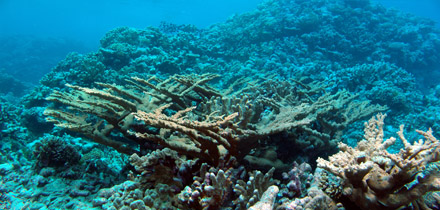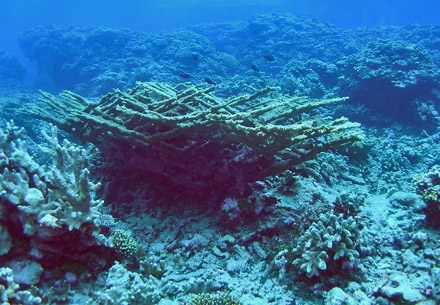Navigation
Super-Rare 'Elkhorn' Coral Found In Pacific
An Australian scientist has discovered what could be the world’s rarest coral in the remote North Pacific Ocean.
 |
| The archetypal divergent branching pattern of the Pacific elkhorn closely resembles that of the Atlantic elkhorn coral - Acropora palmata. Photo courtesy of Dr Maria Beger. |
An Australian scientist has discovered what could be the world’s rarest coral in the remote North Pacific Ocean.
The unique Pacific elkhorn coral was found while conducting underwater surveys of Arno atoll in the Marshall Islands, by coral researcher Dr Zoe Richards of the ARC Centre of Excellence for Coral Reef Studies (CoECRS).
The coral bears a close physical resemblance to the critically endangered and fast-vanishing elkhorn coral (Acropora palmata) of the Atlantic Ocean, but genetic analysis has shown it to be a different species.
“When I first saw it, I was absolutely stunned. The huge colonies - five metres across and nearly two metres high with branches like an elk’s antlers - were like nothing I’d seen before in the Pacific Ocean,” Zoe recounts.
“So far I have only found this new population of coral to occur along a small stretch of reef at a single atoll in the Marshalls group,” Zoe explains. “It grows in relatively shallow water along the exposed reef front and, so far, fewer than 200 colonies are known from that small area.”
 |
| The Pacific elkhorn coral in-situ at Arno Atoll in the Marshall Islands. |
“The Pacific elkhorn coral has regular divergent blade-like branches that radiate out from single or multiple large central stalks. Its colonies are by far the largest of all the Acropora colonies observed at Arno Atoll, indicating that these are relatively old,” she adds.
Whether the Pacific elkhorn is an entirely new species or not is subject to scientific debate, because Zoe has uncovered that over a century ago, in 1898, a scientist called Gardiner described a coral from the island of Rotuma, near Fiji in the South Pacific whose description fits that of the Pacific elkhorn. “Unfortunately at this stage, we do not have any genetic material of A. rotumana to confirm whether or not it is the same species as the Pacific Elkhorn.”
This finding is of a population of elkhorn coral in the Pacific is of particular scientific interest because it represents one morphological extreme in Acropora, the dominant genus of reef-building corals, the researchers say.
Genetic analysis of the new coral found that its closest relative is Acropora abrotanoides. Zoe considers it possible that A. abrotanoides, the 19th century Fijian coral and the new Pacific elkhorn could turn out to be variants of the same species - but says there aren’t enough data to confirm this, at this point.
The uncertainty surrounding the taxonomic status of the Pacific elkhorn poses a conservation dilemma. To be given threatened species status by the International Union for Conservation of Nature (IUCN), more needs to be known about the coral, its population size and it relationships to other coral species.
“Currently the Pacific elkhorn would be rated as ‘data deficient’, meaning there isn’t enough information to determine whether it is threatened, vulnerable or critically endangered,” she explains. This means that the Pacific elkhorn would join 141 other coral species on the IUCN list whose status is uncertain.
However the status of its Atlantic relative, A. palmata is much more certain: regarded by most marine researchers as the outstanding symbol of the plight of Caribbean corals, it is rated as critically endangered after vanishing from most of its Caribbean reef habitat in recent decades.
Zoe says that the current IUCN definitions are unhelpful in terms of the conservation of many rare and newly described corals such as the Pacific elkhorn, adding it is likely that many of the corals classified as ‘data deficient’ are actually at risk of extinction.
“When Zoe showed me pictures of the Pacific elkhorn, I was shocked,” says leading coral geneticist Professor David Miller of CoECRS and James Cook University.
“The colonies look just like the critically endangered Caribbean species A. palmata, one of the most distinctive of all corals. The fact that these colonies might represent a species that has not been seen for over a hundred years (A. rotumana) says something about how much we know about the remote reefs of North Pacific.
Zoe’s discovery is reported in the article Archetypal ‘elkhorn’ coral discovered in the Pacific Ocean by Zoe Richards, Carden Wallace and David Miller which appears in the latest edition of the journal Systematics and Biodiversity (2010), 8(2): 281–288.
This news if from ARC Centre of Excellence for Coral Reef Studies, James Cook University, 28 July 2010.
Value of Deep-sea Corals
from the
U.S. National Oceanic and Atmospheric Administration (NOAA)
As our understanding of deep-sea coral communities and ecosystems has increased, so has our appreciation of their value. Intrinsically valuable as biodiversity hot-spots, deep-sea coral ecosystems are important from a conservation perspective and provide homes for a vast range of marine species. Deep-sea corals may function in ways very similar to their tropical coral reef ecosystem counterparts, providing enhanced feeding opportunities for marine species, hiding places from predators, nursery areas for juveniles, fish spawning sites, and attachment substrate for sedentary invertebrates [a,b,c]
Habitat-forming deep-sea corals are ecologically important, forming the basis of biologically diverse fish and invertebrate communities. For example, the hard coral, Lophelia pertusa forms large, reef-like structures up to 15 m high with levels of diversity that approach those of shallow-water tropical reefs. Deep-sea corals may also serve as habitat and reproductive grounds for certain commercially important fisheries species thus drawing the commercial fishing industry to these fragile areas. In Alaska, for example, studies have revealed rockfish, shrimp, crabs, and other invertebrates are associated with deep-sea coral habitat. [d] Additionally, a number of deep-sea corals are also of commercial importance to the jewelry industry, in particular, black, pink, and red corals.
Finally, deep-sea corals may also serve as important indicators of past climate. Living deep-sea corals have been dated to be more than 1,000 years old, and dead corals forming deep banks have been radiocarbon-dated to be more than 40,000 years old. Stable isotopes incorporated in their skeletons can give clues to past temperatures and analyses of their skeletal microchemistry allow researchers to reconstruct past oceanic conditions [e, f].
Citations:
- Fosså, JH, Mortensen PB, Furevik DM (2002) The deep-water coral Lophelia pertusa in Norwegian waters: distribution and fishery impacts. Hydrobiologia 471:1–12.
- Reed JK (2002) Deep-water Oculina coral reefs of Florida: biology, impacts, and management. Hydrobiologia 471:43–55
- Mortensen PB (2000) Lophelia pertusa in Norwegian waters: distribution, growth and associated fauna. Doctoral dissertation, University of Bergen, Department of Fisheries and Marine Biology
- Krieger KJ, Wing BL (2002) Megafaunal associations with deepwater corals (Primnoa spp.) in the Gulf of Alaska. Hydrobiologia 471:83–90
- Risk MJ, Heikoop JM, Snow MG, Beukens B (2002) Lifespans and growth patterns of two deep sea corals: Primnoa resedaeformis and Desmophyllum cristagalli. Hydrobiologia 471:125–131
- Williams B, Risk MJ, Ross SW, Sulak KJ (2006) Deep-water Antipatharians: proxies of environmental change. Geology 34(9):773–776
Search
Latest articles
Agriculture
- World Water Week: Healthy ecosystems essential to human health: from coronavirus to malnutrition Online session Wednesday 24 August 17:00-18:20
- World Water Week: Healthy ecosystems essential to human health: from coronavirus to malnutrition Online session Wednesday 24 August 17:00-18:20
Air Pollution
- "Water and Sanitation-Related Diseases and the Changing Environment: Challenges, Interventions, and Preventive Measures" Volume 2 Is Now Available
- Global Innovation Exchange Co-Created by Horizon International, USAID, Bill and Melinda Gates Foundation and Others
Biodiversity
- It is time for international mobilization against climate change
- World Water Week: Healthy ecosystems essential to human health: from coronavirus to malnutrition Online session Wednesday 24 August 17:00-18:20
Desertification
- World Water Week: Healthy ecosystems essential to human health: from coronavirus to malnutrition Online session Wednesday 24 August 17:00-18:20
- UN Food Systems Summit Receives Over 1,200 Ideas to Help Meet Sustainable Development Goals
Endangered Species
- Mangrove Action Project Collaborates to Restore and Preserve Mangrove Ecosystems
- Coral Research in Palau offers a “Glimmer of Hope”
Energy
- Global Innovation Exchange Co-Created by Horizon International, USAID, Bill and Melinda Gates Foundation and Others
- Wildlife Preservation in Southeast Nova Scotia
Exhibits
- Global Innovation Exchange Co-Created by Horizon International, USAID, Bill and Melinda Gates Foundation and Others
- Coral Reefs
Forests
- NASA Satellites Reveal Major Shifts in Global Freshwater Updated June 2020
- Global Innovation Exchange Co-Created by Horizon International, USAID, Bill and Melinda Gates Foundation and Others
Global Climate Change
- It is time for international mobilization against climate change
- It is time for international mobilization against climate change
Global Health
- World Water Week: Healthy ecosystems essential to human health: from coronavirus to malnutrition Online session Wednesday 24 August 17:00-18:20
- More than 400 schoolgirls, family and teachers rescued from Afghanistan by small coalition
Industry
- "Water and Sanitation-Related Diseases and the Changing Environment: Challenges, Interventions, and Preventive Measures" Volume 2 Is Now Available
- Global Innovation Exchange Co-Created by Horizon International, USAID, Bill and Melinda Gates Foundation and Others
Natural Disaster Relief
- STOP ATTACKS ON HEALTH CARE IN UKRAINE
- Global Innovation Exchange Co-Created by Horizon International, USAID, Bill and Melinda Gates Foundation and Others
News and Special Reports
- World Water Week: Healthy ecosystems essential to human health: from coronavirus to malnutrition Online session Wednesday 24 August 17:00-18:20
- STOP ATTACKS ON HEALTH CARE IN UKRAINE
Oceans, Coral Reefs
- World Water Week: Healthy ecosystems essential to human health: from coronavirus to malnutrition Online session Wednesday 24 August 17:00-18:20
- Mangrove Action Project Collaborates to Restore and Preserve Mangrove Ecosystems
Pollution
- Zakaria Ouedraogo of Burkina Faso Produces Film “Nzoue Fiyen: Water Not Drinkable”
- "Water and Sanitation-Related Diseases and the Changing Environment: Challenges, Interventions, and Preventive Measures" Volume 2 Is Now Available
Population
- "Water and Sanitation-Related Diseases and the Changing Environment: Challenges, Interventions, and Preventive Measures" Volume 2 Is Now Available
- "Water and Sanitation-Related Diseases and the Changing Environment: Challenges, Interventions, and Preventive Measures" Volume 2 Is Now Available
Public Health
- Honouring the visionary behind India’s sanitation revolution
- Honouring the visionary behind India’s sanitation revolution
Rivers
- World Water Week: Healthy ecosystems essential to human health: from coronavirus to malnutrition Online session Wednesday 24 August 17:00-18:20
- Mangrove Action Project Collaborates to Restore and Preserve Mangrove Ecosystems
Sanitation
- Honouring the visionary behind India’s sanitation revolution
- Honouring the visionary behind India’s sanitation revolution
Toxic Chemicals
- "Water and Sanitation-Related Diseases and the Changing Environment: Challenges, Interventions, and Preventive Measures" Volume 2 Is Now Available
- Actions to Prevent Polluted Drinking Water in the United States
Transportation
- "Water and Sanitation-Related Diseases and the Changing Environment: Challenges, Interventions, and Preventive Measures" Volume 2 Is Now Available
- Urbanization Provides Opportunities for Transition to a Green Economy, Says New Report
Waste Management
- Honouring the visionary behind India’s sanitation revolution
- Honouring the visionary behind India’s sanitation revolution
Water
- Honouring the visionary behind India’s sanitation revolution
- Honouring the visionary behind India’s sanitation revolution
Water and Sanitation
- Honouring the visionary behind India’s sanitation revolution
- Honouring the visionary behind India’s sanitation revolution

